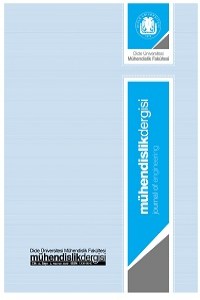Abstract
Bu çalışmada, barit tozu ile üretilmiş Kendiliğinden Yerleşen Harçların
(KYH) mekanik özelliklerini araştırılmıştır. Barit tozu, mineral katkı maddesi
olarak ağırlıkça beyaz çimento ile ikame edilmiştir. Toplam çimento ağırlığının
%5, %10, %20 ve %30 oranında barit tozundan oluşan karışım ile kontrol karışımı
içeren toplamda beş seri KYH hazırlanmıştır. Test gününe kadar 7, 28 ve 56 gün
boyunca kür havuzunda bekletilen sertleşmiş numuneler üzerinde basınç ve eğilme
dayanımlarının belirlenmesi için toplam 45 adet 40x40x160 mm numune üretilmiş
ve teste tabi tutulmuştur. Karışımların KYH standartlarına ve reolojik
özelliklere uygunluğunu değerlendirmek için taze harç üzerinde mini V-hunisi,
akış zamanı ve mini çökme/yayılma testleri yapılmıştır. Kendinden yerleşebilme
özellikleri ikame oranı artışıyla her ne kadar düşmüşse bile, EFNARC
standardının belirlediği sınırlar arasında kalmıştır. En iyi dayanım sonuçları,
kontrol numunelerine kıyasla %10 oranında barit tozu ile beyaz çimentonun ikame
edildiği numunelerden elde edilmiştir.
References
- ASTM C-348, (2008) American Standard of Testing Material, Standard Test Method for Flexural Strength of Hydraulic-Cement Mortars.
- ASTM C-349, (2008) American Standard of Testing Material, Standard Test Method for Compressive Strength of Hydraulic-Cement Mortars (Using Portions of Prisms Broken in Flexure).
- Cemalgil, S., Onat, O. (2016). Compressive strength and abrasion resistance of concrete with waste marble and demolition aggregate. International Journal of Pure and Applied Sciences, 2(1).
- Cemalgil, S., Etli, S., Onat, O. (2018). Curing effect on mortar properties produced with styrene-butadiene rubber. Computers and Concrete, 21(6), 705-715.
- EFNARC, (2004) The European guidelines for self-compacting concrete specification, production and use. The European Federation of specialist construction chemicals and concrete systems.
- Gönen, T., Onat, O., Cemalgil, S., Yılmazer, B., Altuncu, Y. T. (2012). A review on new waste materials for concrete technology. Electronic Journal of Construction Technologies, 8(1), 36-43.
- http://www.mta.gov.tr/v3.0/bilgi-merkezi/barit
- Janković, K., Stanković, S., Bojović, D., Stojanović, M., Antić, L. (2016) The influence of nano-silica and barite aggregate on properties of ultra-high-performance concrete. Construction and Building Materials, 126, 147-156.
- Kilincarslan, S., Akkurt, I., Basyigit, C. (2006) The effect of barite rate on some physical and mechanical properties of concrete. Materials Science and Engineering: A, 424(1-2), 83-86.
- Saidani, K., Ajam, L., Ouezdou, M. B. (2015) Barite powder as sand substitution in concrete: Effect on some mechanical properties. Construction and Building Materials, 95, 287-295.
Abstract
References
- ASTM C-348, (2008) American Standard of Testing Material, Standard Test Method for Flexural Strength of Hydraulic-Cement Mortars.
- ASTM C-349, (2008) American Standard of Testing Material, Standard Test Method for Compressive Strength of Hydraulic-Cement Mortars (Using Portions of Prisms Broken in Flexure).
- Cemalgil, S., Onat, O. (2016). Compressive strength and abrasion resistance of concrete with waste marble and demolition aggregate. International Journal of Pure and Applied Sciences, 2(1).
- Cemalgil, S., Etli, S., Onat, O. (2018). Curing effect on mortar properties produced with styrene-butadiene rubber. Computers and Concrete, 21(6), 705-715.
- EFNARC, (2004) The European guidelines for self-compacting concrete specification, production and use. The European Federation of specialist construction chemicals and concrete systems.
- Gönen, T., Onat, O., Cemalgil, S., Yılmazer, B., Altuncu, Y. T. (2012). A review on new waste materials for concrete technology. Electronic Journal of Construction Technologies, 8(1), 36-43.
- http://www.mta.gov.tr/v3.0/bilgi-merkezi/barit
- Janković, K., Stanković, S., Bojović, D., Stojanović, M., Antić, L. (2016) The influence of nano-silica and barite aggregate on properties of ultra-high-performance concrete. Construction and Building Materials, 126, 147-156.
- Kilincarslan, S., Akkurt, I., Basyigit, C. (2006) The effect of barite rate on some physical and mechanical properties of concrete. Materials Science and Engineering: A, 424(1-2), 83-86.
- Saidani, K., Ajam, L., Ouezdou, M. B. (2015) Barite powder as sand substitution in concrete: Effect on some mechanical properties. Construction and Building Materials, 95, 287-295.
Details
| Primary Language | Turkish |
|---|---|
| Journal Section | Articles |
| Authors | |
| Publication Date | June 15, 2020 |
| Submission Date | July 10, 2019 |
| Published in Issue | Year 2020 Volume: 11 Issue: 2 |


